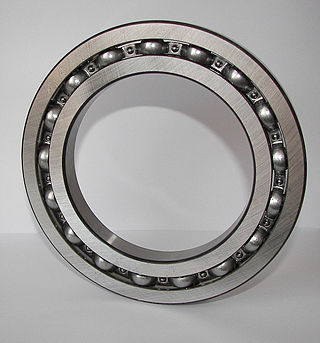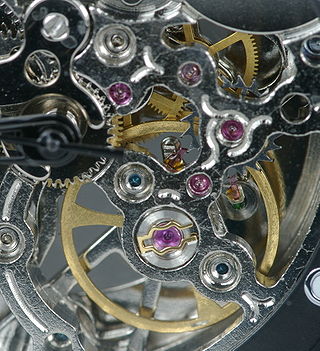
An axle or axletree is a central shaft for a rotating wheel or gear. On wheeled vehicles, the axle may be fixed to the wheels, rotating with them, or fixed to the vehicle, with the wheels rotating around the axle. In the former case, bearings or bushings are provided at the mounting points where the axle is supported. In the latter case, a bearing or bushing sits inside a central hole in the wheel to allow the wheel or gear to rotate around the axle. Sometimes, especially on bicycles, the latter type of axle is referred to as a spindle.

A bearing is a machine element that constrains relative motion to only the desired motion and reduces friction between moving parts. The design of the bearing may, for example, provide for free linear movement of the moving part or for free rotation around a fixed axis; or, it may prevent a motion by controlling the vectors of normal forces that bear on the moving parts. Most bearings facilitate the desired motion by minimizing friction. Bearings are classified broadly according to the type of operation, the motions allowed, or the directions of the loads (forces) applied to the parts.

A strut is a structural component commonly found in engineering, aeronautics, architecture and anatomy. Struts generally work by resisting longitudinal compression, but they may also serve in tension.

A plain bearing, or more commonly sliding contact bearing and slide bearing, is the simplest type of bearing, comprising just a bearing surface and no rolling elements. Therefore, the part of the shaft in contact with the bearing slides over the bearing surface. The simplest example of a plain bearing is a shaft rotating in a hole. A simple linear bearing can be a pair of flat surfaces designed to allow motion; e.g., a drawer and the slides it rests on or the ways on the bed of a lathe.

A jewel bearing is a plain bearing in which a metal spindle turns in a jewel-lined pivot hole. The hole is typically shaped like a torus and is slightly larger than the shaft diameter. The jewels are typically made from the mineral corundum, usually either synthetic sapphire or synthetic ruby. Jewel bearings are used in precision instruments where low friction, long life, and dimensional accuracy are important. Their main use is in mechanical watches.

A double wishbone suspension is an independent suspension design for automobiles using two wishbone-shaped arms to locate the wheel. Each wishbone or arm has two mounting points to the chassis and one joint at the knuckle. The shock absorber and coil spring mount to the wishbones to control vertical movement. Double wishbone designs allow the engineer to carefully control the motion of the wheel throughout suspension travel, controlling such parameters as camber angle, caster angle, toe pattern, roll center height, scrub radius, scuff, and more.

ETA SA Manufacture Horlogère Suisse designs and manufactures quartz watches and both hand-wound and automatic-winding mechanical ébauches and movements. Commonly referred to as ETA, the company is headquartered in Grenchen, Switzerland, and is a wholly owned subsidiary of The Swatch Group.

In horology, a tourbillon is an addition to the mechanics of a watch escapement to increase accuracy. Conceived by the British watchmaker and inventor John Arnold, it was developed by his friend the Swiss-French watchmaker Abraham-Louis Breguet and patented by Breguet on 26 June 1801. In a tourbillon the escapement and balance wheel are mounted in a rotating cage, with the goal of eliminating errors of poise in the balance giving a uniform weight.

The pallet fork is a component of the lever escapement of a mechanical watch. The pallet fork and the lever form one component that sits between the escape wheel and the balance wheel. Its purpose is to lock the escape wheel, and release it one tooth at a time at each swing of the balance wheel, and also give the balance wheel small pushes to keep it going.

An automatic watch, also known as a self-winding watch or simply an automatic, is a mechanical watch where the natural motion of the wearer provides energy to wind the mainspring, making manual winding unnecessary if worn enough. It is distinguished from a manual watch in that a manual watch must have its mainspring wound by hand at regular intervals.

In an automobile, ball joints are spherical bearings that connect the control arms to the steering knuckles, and are used on virtually every automobile made. They bionically resemble the ball-and-socket joints found in most tetrapod animals.

A mechanical watch is a watch that uses a clockwork mechanism to measure the passage of time, as opposed to quartz watches which function using the vibration modes of a piezoelectric quartz tuning fork, or radio watches, which are quartz watches synchronized to an atomic clock via radio waves. A mechanical watch is driven by a mainspring which must be wound either periodically by hand or via a self-winding mechanism. Its force is transmitted through a series of gears to power the balance wheel, a weighted wheel which oscillates back and forth at a constant rate. A device called an escapement releases the watch's wheels to move forward a small amount with each swing of the balance wheel, moving the watch's hands forward at a constant rate. The escapement is what makes the 'ticking' sound which is heard in an operating mechanical watch. Mechanical watches evolved in Europe in the 17th century from spring powered clocks, which appeared in the 15th century.

A marine chronometer is a precision timepiece that is carried on a ship and employed in the determination of the ship's position by celestial navigation. It is used to determine longitude by comparing Greenwich Mean Time (GMT), and the time at the current location found from observations of celestial bodies. When first developed in the 18th century, it was a major technical achievement, as accurate knowledge of the time over a long sea voyage was vital for effective navigation, lacking electronic or communications aids. The first true chronometer was the life work of one man, John Harrison, spanning 31 years of persistent experimentation and testing that revolutionized naval navigation.

A chronometer is an extraordinarily accurate mechanical timepiece, with an original focus on the needs of maritime navigation. In Switzerland, timepieces certified by the Contrôle Officiel Suisse des Chronomètres (COSC) may be marked as Certified Chronometer or Officially Certified Chronometer. Outside Switzerland, equivalent bodies, such as the Japan Chronometer Inspection Institute, have in the past certified timepieces to similar standards, although use of the term has not always been strictly controlled.

The Geneva Seal (English), Poinçon de Genève (French), or Genfer Siegel (German) is the official seal of the City and Canton of Geneva, Switzerland. When a variation of the official seal is applied to wristwatch movements, the Geneva Seal is the quality seal of the Watchmaking School of Geneva and it has an official purpose as defined by the law.
Shock resistant is a common mark stamped on the back of wrist watches to indicate how well a watch copes with mechanical shocks. In a mechanical watch, it indicates that the delicate pivots that hold the balance wheel are mounted in a spring suspension system intended to protect them from damage if the watch is dropped. One of the earliest and most widely used was the Incabloc system, invented in 1934. Before the widespread adoption of shock-resistant balance pivots in the 1950s, broken balance wheel staffs were a common cause of watch repairs.
In horology, a wheel train is the gear train of a mechanical watch or clock. Although the term is used for other types of gear trains, the long history of mechanical timepieces has created a traditional terminology for their gear trains which is not used in other applications of gears.

Jean Lassale was a Swiss watch company that designed the Calibre 1200, featuring the thinnest mechanical watch movement: 1.2 mm. In the 1970s, Pierre Mathys, master watchmaker in La Chaux-de-Fonds, designed and built the prototype of a revolutionary watch caliber, with the goal of making the thinnest watch in the world. To achieve this feat, Mathys based his design on the work of Robert Annen, who previously had the idea of using ball bearings in small scale horology. Mathys decided to remove the bridges and counter-pivot, and instead use ball bearings for the axis.
















